Can
You
Dig
It?
Museums showcase millions of years of history from paleontology excavation sites across Texas
By Asher Elbein
Illustrations by RJ Palmer
Dimetrodon fossils on display at the Whiteside Museum of Natural History in Seymour. Photo by Tom McCarthy Jr.
The desert songbird flits out from the shade, snatching up an insect and returning to its perch on the wing of the replica Quetzalcoatlus, one of the largest flying animals to ever live. I’m standing in the Big Bend Fossil Discovery Exhibit, an open pavilion that serves as a museum and memorial to the fossil treasures of the state’s largest national park—and a place where the past and future seem to touch.
That’s true across much of the state. Texas’ rocks span almost a billion years, from the first land ecosystems to the remains of animals that disappeared—in geological time—only yesterday. In between, oceans advanced and retreated, habitats and climates changed, and incredible animals roamed the state.
Fossil riches have long attracted collectors and paleontologists to Texas, and many of the state’s remarkable remains have ended up in out-of-state collections. But today, researchers from local institutions are working to uncover, and take ownership of, the state’s distant past. Some are launching expeditions to previously collected areas. Others are diving back into Texas collections to find neglected treasures.
That work occurs across many Texas landscapes, from the dramatic hillsides and deserts of Big Bend to the high rangeland and red rocks of North Texas to the live oak forests of the Hill Country. A wealth of fossils awaits visitors at museums in every corner of the state, showcasing the wide-ranging discoveries, new and old, that reveal what came before.
Whiteside Museum of Natural History
In the red dirt country of the Craddock Ranch outside Seymour, a small town 133 miles northwest of Fort Worth, bits of teeth and skulls litter the washes, and the bones of strange creatures erode from the hillsides. These rust-colored slopes represent the first great flowering of land vertebrates—and the Whiteside Museum of Natural History’s stomping grounds.
The museum is a handsome little building downtown that displays a remarkable array of early Permian fossils. Standouts include partially complete Dimetrodons; giant amphibians like Eryops; and ancient plants, fish, and insects from the Craddock Ranch.
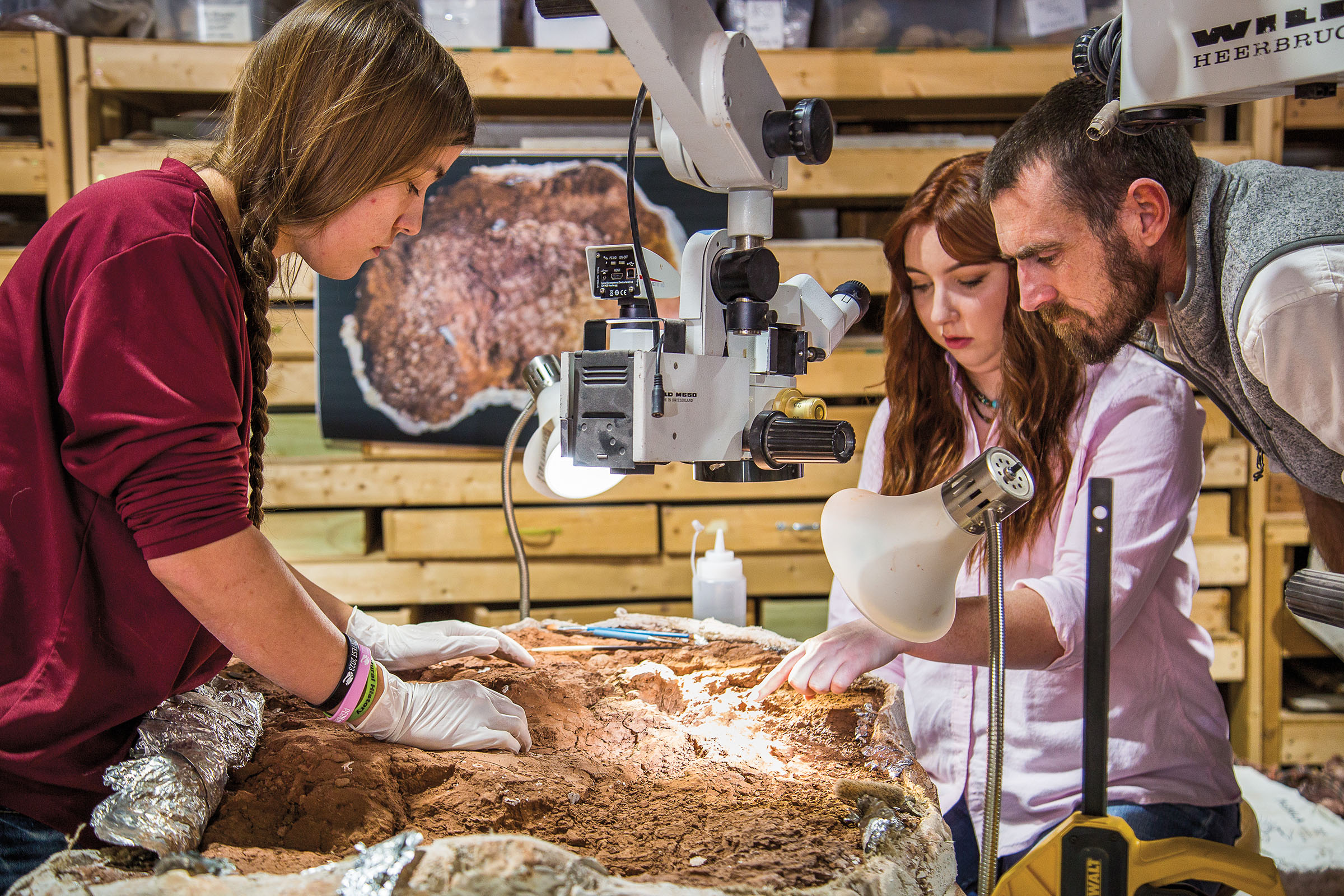
Curatorial assistant McKinzi Donnell (left), assistant museum director Holly Simon, and museum director Chris Flis discuss a block from the nearby dig site that contains 12 fossilized baby Seymouria. Photo by Tom McCarthy Jr.
I join museum director Christopher Flis and curatorial assistant (and college senior) McKinzi Donnell on an early morning visit to the museum’s private quarries. With the permission of the landowners, museum staff and volunteers have spent years digging into a set of crumbling hillsides. Now, one quarry contains a massive plaster-wrapped block of Dimetrodon skeletons waiting to be removed. Other spots have tarps covering half-excavated remains.
Millions of years ago, the quarry was a set of seasonally flooded oxbow lakes, Flis says. It was an era long before dinosaurs. Instead, the waters thronged with eel-like river sharks and boomerang-headed amphibians. Prowling the shorelines were early members of the synapsids, the family that would one day give rise to mammals. The most famous residents of Seymour, at least in the Permian era, were toothy, fin-backed predators called Dimetrodon, whose caliche-encrusted jaws, limbs, and spines pack the Whiteside Museum collections.
Get high enough up the bank, and the ancient mud gives way to more arid sediments, representing the death of the wetlands—and the ecosystem. “In the Permian, things are really starting to dry out,” Flis says as we chip away at sediment. “The hot seasons are getting hotter, and the rainy seasons are farther and fewer between, which is something that’s happening now.”
The heat and drought last summer were fierce enough to cut the museum’s field season short. But erosion waits for nobody. As soon as we settle in, Flis and Donnell begin work on a newly exposed Dimetrodon limb bone. I pick up treasures that have eroded out with the spring rains: folded skull fragments of the boomerang-headed amphibian Diplocaulus; a piece of spine from a river shark; and the teeth, vertebrae, and back struts of Dimetrodons.
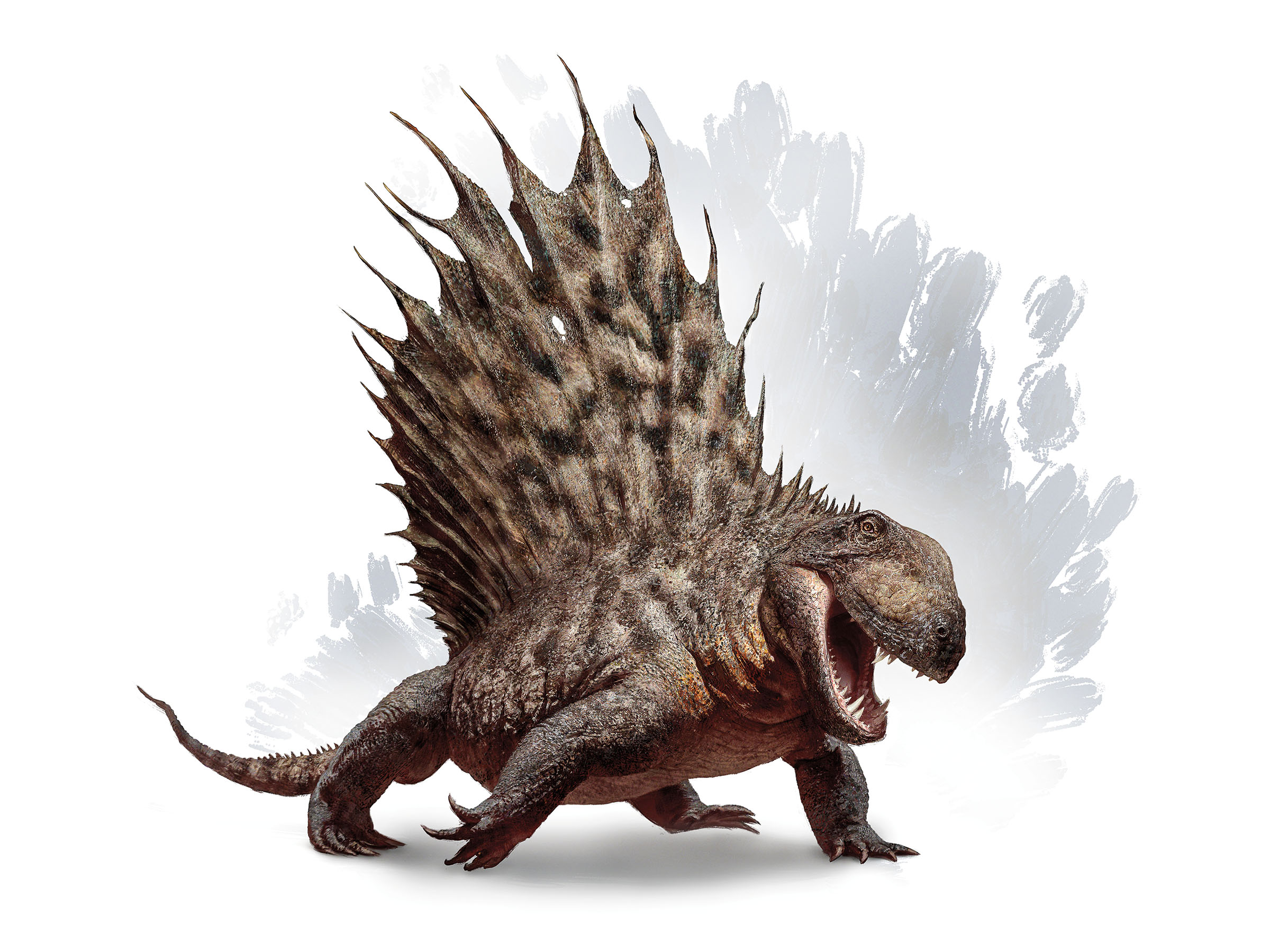
The abundance of aquatic life suggests fish and amphibians, not land herbivores, were the basis of the ecosystem. And well-chewed Dimetrodon bones mean that when they weren’t fishing, the fin-backed carnivores were enthusiastic cannibals. “How do you balance an ecosystem when you’re 99% carnivores?” Donnell says. “They’re just eating each other.”
It couldn’t last. Eventually, the oxbows of the Craddock dried up, and 20 million years later, an apocalyptic mass extinction spelled the end of synapsid-dominated ecosystems—for a while, at least. But the bones remain, a monument to one of the best Permian bone beds in the world.
Whiteside Museum of Natural History
310 N. Washington St., Seymour.
Open Tue-Sat 10 a.m.-4 p.m.,
Sun noon-4 p.m. 940-889-6548; wmnh.org
Dimetrodon
286-270 million years ago
Often mistaken for a dinosaur, this Permian-era synapsid had a large sail on its back and various sizes of teeth, lending it the name “Dimetrodon,” which translates to “two measures of tooth.”
Museum of Texas Tech University
The caprock landscapes just south of Lubbock are full of rust-red and blood-brown folds of sandstone, erupting like dragon spines from the hills. These deposits, the remnant of forests bordering the headwaters of a river larger than today’s Mississippi, are from the Triassic period. It was a time of recovery from the Permian mass extinction, says Sankar Chatterjee, professor emeritus at Texas Tech. It was also an incubator for many of the animal families alive today.
When Chatterjee arrived at Texas Tech in 1980, the nearby deposits caught his interest. He quickly struck an agreement to dig on private ranchlands around Post, a small town 41 miles southeast of Lubbock.
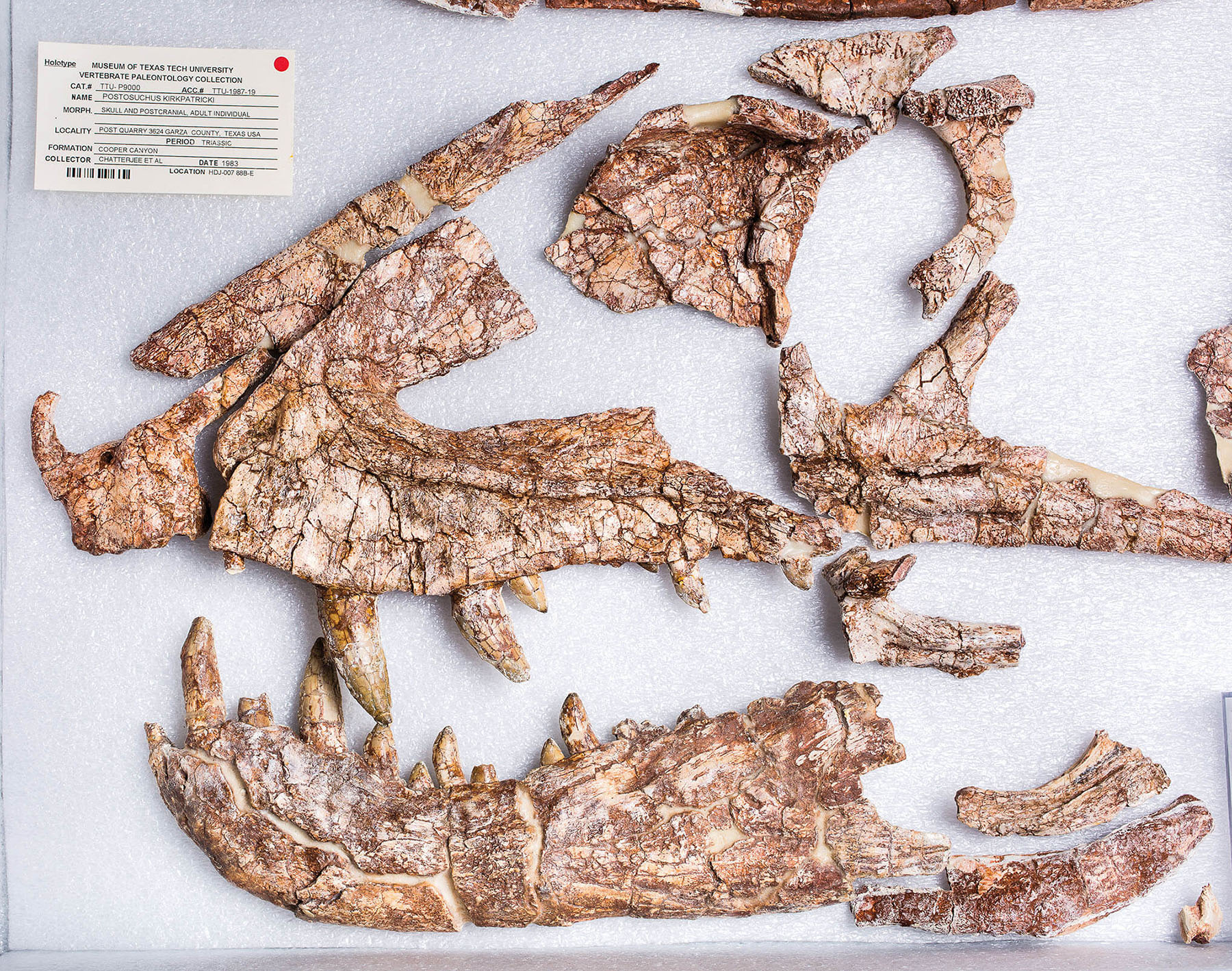
Fossilized bones of a Postosuchus skull from the vertebrate paleontology collection at the Museum of Texas Tech University. Photo by Tom McCarthy Jr.
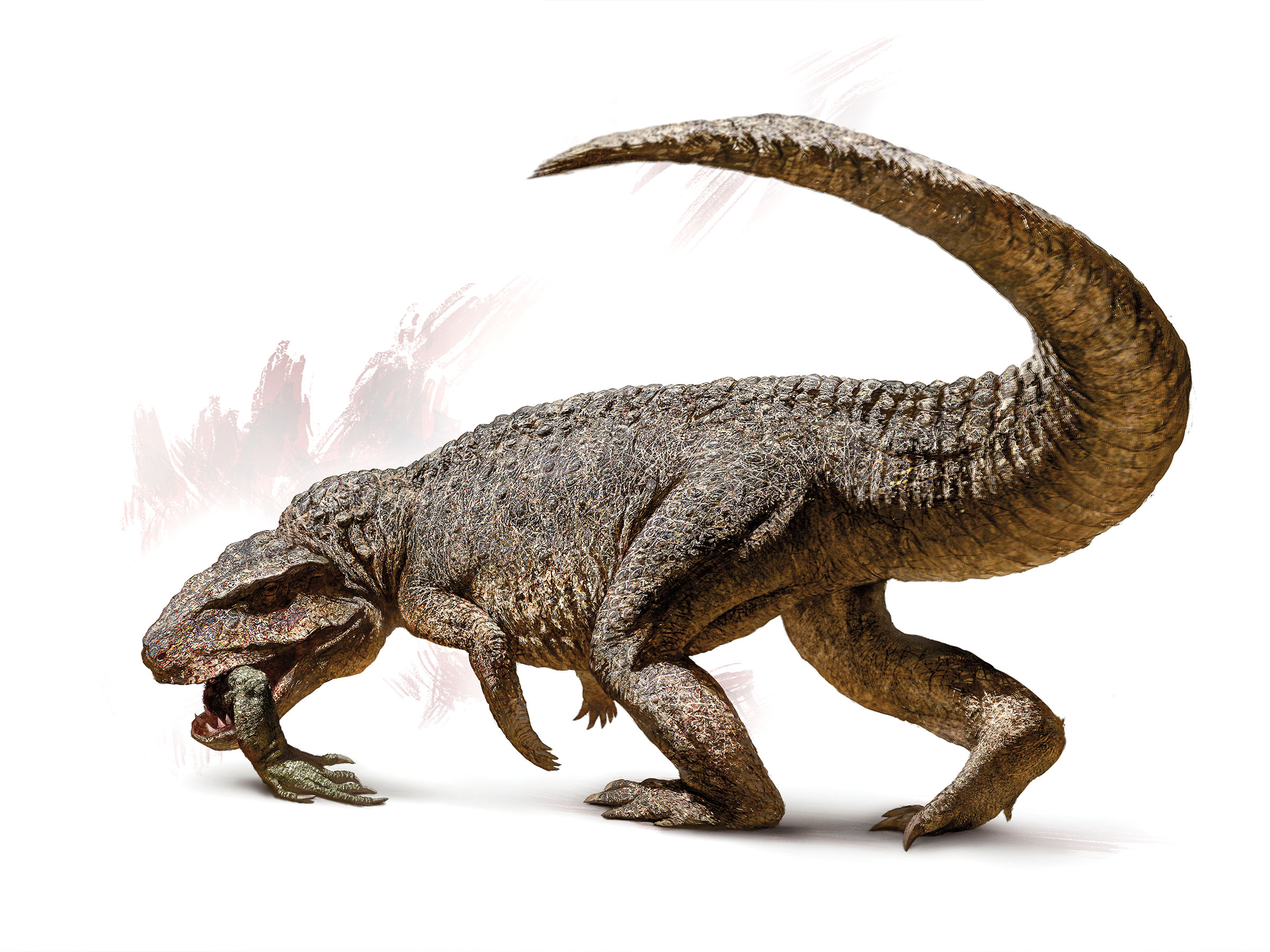
Postosuchus
237-201.3 million years ago
This Late Triassic apex predator is named for a quarry in the town of Post, where many of its remains have been uncovered. The bipedal creature stood 4 feet tall and 16 feet long.
TEXAS’ STATE DINOSAUR:
A TRUE THUNDER LIZARD
Originally known by the name Paluxysaurus—the moniker under which it was formally adopted as the Lone Star State’s signature fossil—the remains were reclassified under the dinosaur Sauroposeidon in 2012. It holds the title as arguably the longest dinosaur species ever found in Texas, reaching a maximum height of 69 feet and stretching as long as 112 feet. A full-scale rendering of Paluxysaurus Jonesi greets visitors in the Fort Worth Museum of Science History’s atrium.
Over decades of excavations, Chatterjee and his colleagues at Texas Tech acquired a remarkable collection of Triassic material, now stored at the Museum of Texas Tech University, an enormous building in Lubbock with multiple displays on science and culture. Paleontology enthusiasts shouldn’t miss the central display of a Tyrannosaurus making the unwise decision to attack a Triceratops head-on, or the displays on the Triassic fauna of the Panhandle, including mounted replica skeletons of Postosuchus, Technosaurus, and the “proto-bird” Protoavis. Other exhibits discuss the evolution of pterosaurs, Antarctic dinosaurs, and other Texas fossil animals.
Under the museum in areas reserved for researchers, ranks of cabinets hold the remains of the ancient river lands’ denizens, including skulls of huge, shovel-headed amphibians. Multiple cabinets pack in remains of crocodile-like reptiles called phytosaurs. But most notable are the variety of archosaurs, reptiles whose family tree gave rise with one branch to crocodiles and with another to dinosaurs and birds.
Most Post area reptiles are from the crocodile line of the archosaur family tree. That includes animals like Desmatosuchus—armored armadillo-crocodiles—and Shuvosaurus, an animal closely resembling birdlike dinosaurs that was discovered by Chatterjee’s son when he was in elementary school.
“Many people do not understand that dinosaurs are basically imposters,” Chatterjee says. “Crocodiles are the pioneers.”
Most famous of these forerunners was Postosuchus, a 4-foot-tall, 16-foot-long bipedal predator with powerful jaws. It’s Chatterjee’s contention that these fearsome crocodile relatives helped keep early dinosaurs small—until a minor mass extinction, combined with dinosaurian anatomy that allowed them to run quicker and more efficiently, gave them the upper hand. “For a reptilian predator, you can’t have a better design,” Chatterjee says. “It’s a beautiful skeleton.”
Museum of Texas Tech University
3301 Fourth St., Lubbock. Open Tue-Sat 10 a.m.-5 p.m., Sun 1-5 p.m.
806-742-2490; depts.ttu.edu/museumttu
Big Bend Fossil Exhibit
There are places in Texas where the right hike can take you across millions of years. At Big Bend National Park, millennia of changing ecosystems sit in jumbled deposits, providing a snapshot of some of the Cretaceous period’s most spectacular and charismatic animals.
On a visit to the park last summer, I walk across desert flats with Sul Ross State University paleontologist Thomas Shiller, crossing through millions of years of different environments as the colors and consistency of the dirt and rocks change. Over several million years, Shiller says, landscapes of the Big Bend transformed from shallow seas to coastal marshes and deltas, grazed by duckbills and horned dinosaurs.
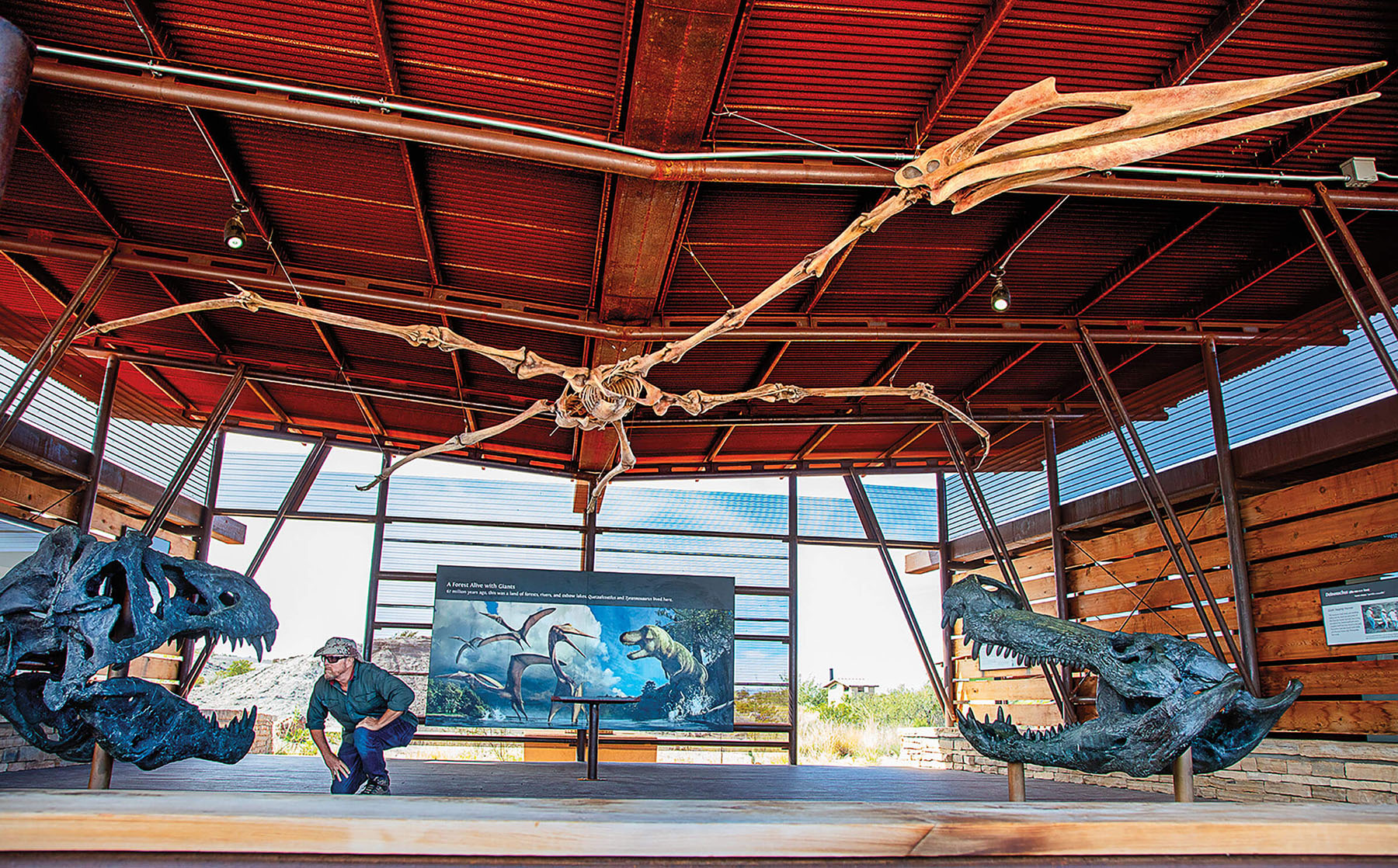
A Quetzalcoatlus soars from the top of the Big Bend Fossil Exhibit at Big Bend National Park. Photo by E. Dan Klepper
Barnum Brown, the flamboyant discoverer of the T. rex, arrived in 1940 with his colleague, Roland T. Bird, to prospect across the remote hills and draws. They loaded hundreds of pounds of fossil remains into a Ford delivery wagon that was forced to maneuver along treacherous roads. Among their finds was the nearly complete skull of Deinosuchus, Shiller says, a crocodilian almost 40 feet long that chomped delta turtles and dinosaurs with equal enthusiasm. A replica of its skull is on display at the Big Bend Fossil Discovery Exhibit eight minutes north of Panther Junction. The large open-air structure features beautifully illustrated murals, and display cases contain numerous real and cast fossils of species from the park. These range from turtles and ancient mammals to the enormous horned dinosaur Bravoceratops.
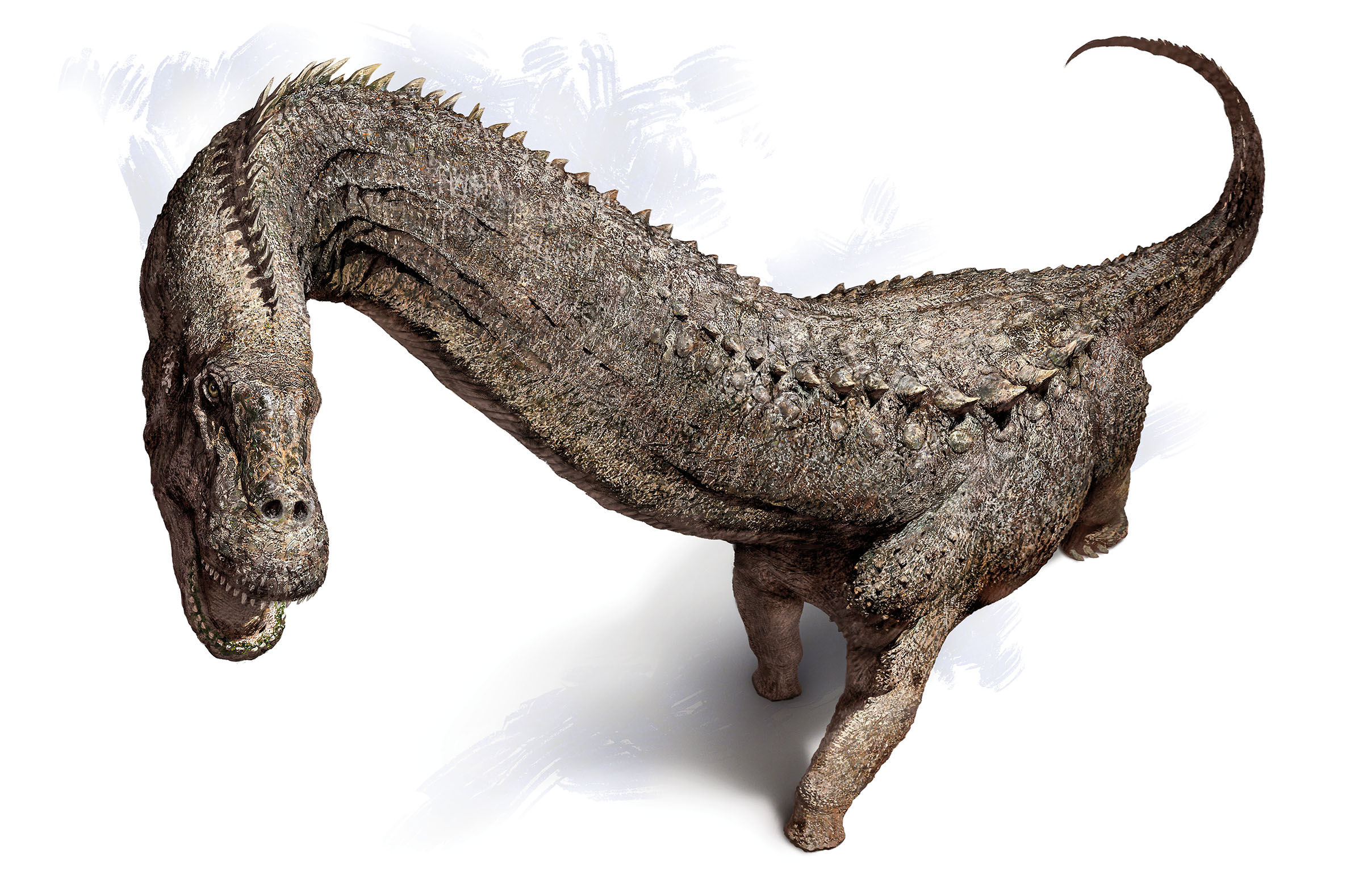
As the seashore retreated east and the landscape dried, Shiller says, the marshes gave way to seasonal floodplains full of stands of 100-foot trees, some of which remain in copses of fossilized stumps. These plains were home to giant long-necked dinosaurs like Alamosaurus, whose massive skeletal remains were air-lifted out by helicopter in 2001. There were giant horned dinosaurs like Bravoceratops, innumerable herbivorous duck-billed dinosaurs, and two as-yet-unidentified meat-eating dinosaurs.
They also were home to the giant pterosaur Quetzalcoatlus, a giraffe-sized flying reptile discovered in 1971. Shiller leads me up to the remains of the original quarry, where then-grad student Douglas Lawson came upon the fossil of an enormous wing eroding from a white hillside. The quarry is now a worn, unassuming divot, the forces of erosion slowly reclaiming the site.
Just over the lip of a little saddleback ridge, a 5-meter debris field lies between two sets of banded hillsides. Somewhere in between, the dinosaur bones stop, and the age of the terrible lizards ends forever.
Fossil Discovery Exhibit
Located in Big Bend National Park, 8 miles north of Panther Junction on US 385. Open dawn to dusk. 432-477-2251; fossildiscoveryexhibit.com
Alamosaurus
83.6-66 million years ago
Standing at nearly 100 feet tall, the Alamosaurus was an herbivore that devoured the similarly tall trees that once covered the Big Bend area in the age of the dinosaurs.
Waco Mammoth National Monument
The story of the Waco Mammoth National Monument begins unceremoniously. In 1978, two teenage boys from Waco discovered a chunk of something they took to be a bone while wandering on private property looking for arrowheads and fossils. Scientists at Baylor University quickly identified it as a piece of Columbian mammoth—the larger, likely sparsely furred southern relative of the more familiar woolly mammoth. For two decades beginning in the 1970s, scientists from Baylor and local volunteers dug into crumbling sediments searching for mammoth remains. Eventually they hit the mother lode: a tangle of individuals of varying sizes that likely represents the only known Columbian mammoth nursery herd.
“All of this excavation was done primarily on volunteer time,” says Brycen Turnbull, formerly the site’s lead ranger. As the finds mounted, Waco residents banded together to raise funds: first to establish a city park, then to finance the construction of a state-of-the-art dig shelter. Finally, citizens successfully lobbied to have the site declared a national monument in 2015.
Columbian Mammoth
1.5 million-10,000 years ago
One of the last species of mammoth to roam the earth, the Pleistocene-era animal was likely far less hairy than the woolly mammoth due to its habitat in warmer climates.
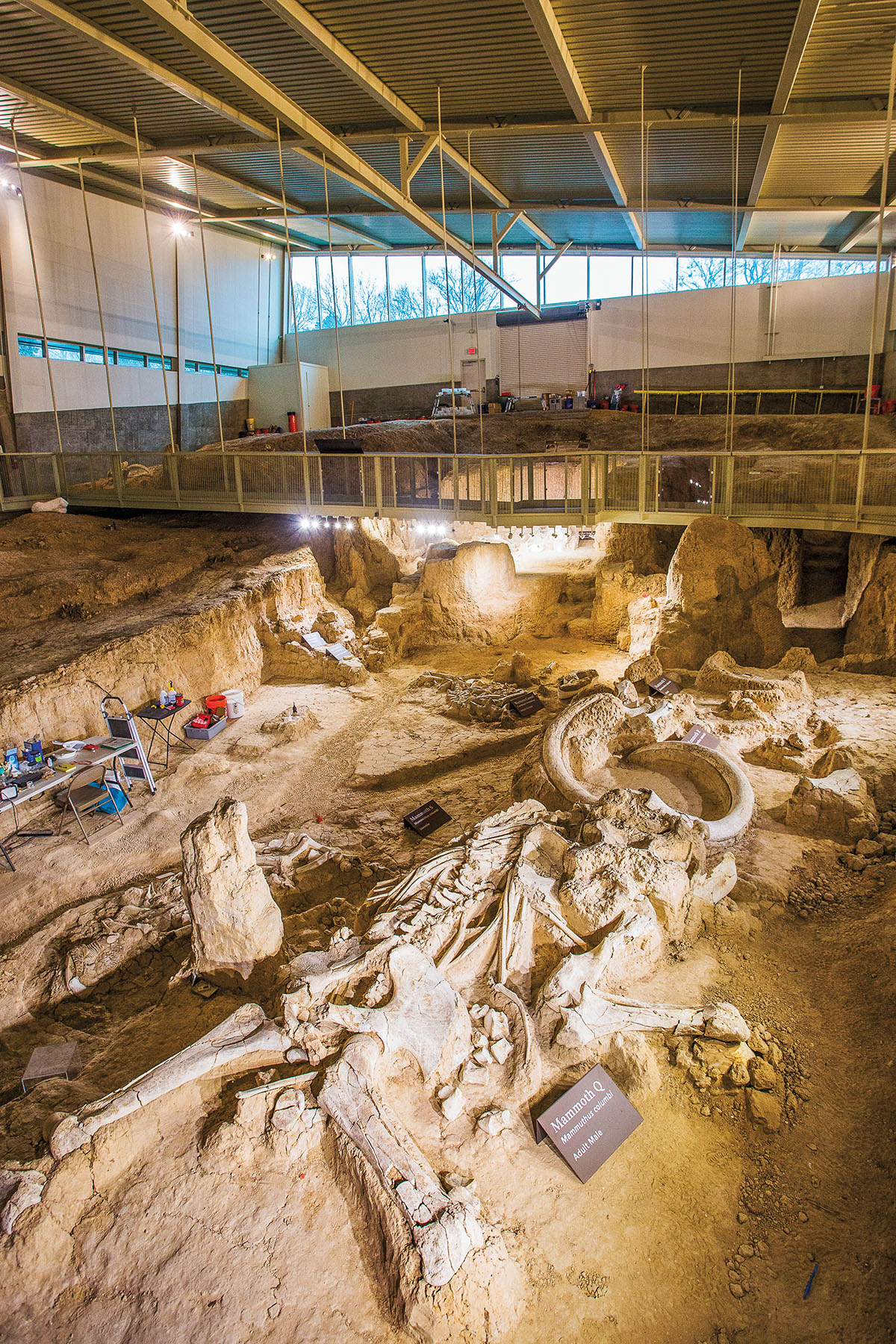
The climate-controlled dig shelter at Waco Mammoth Site National Monument.
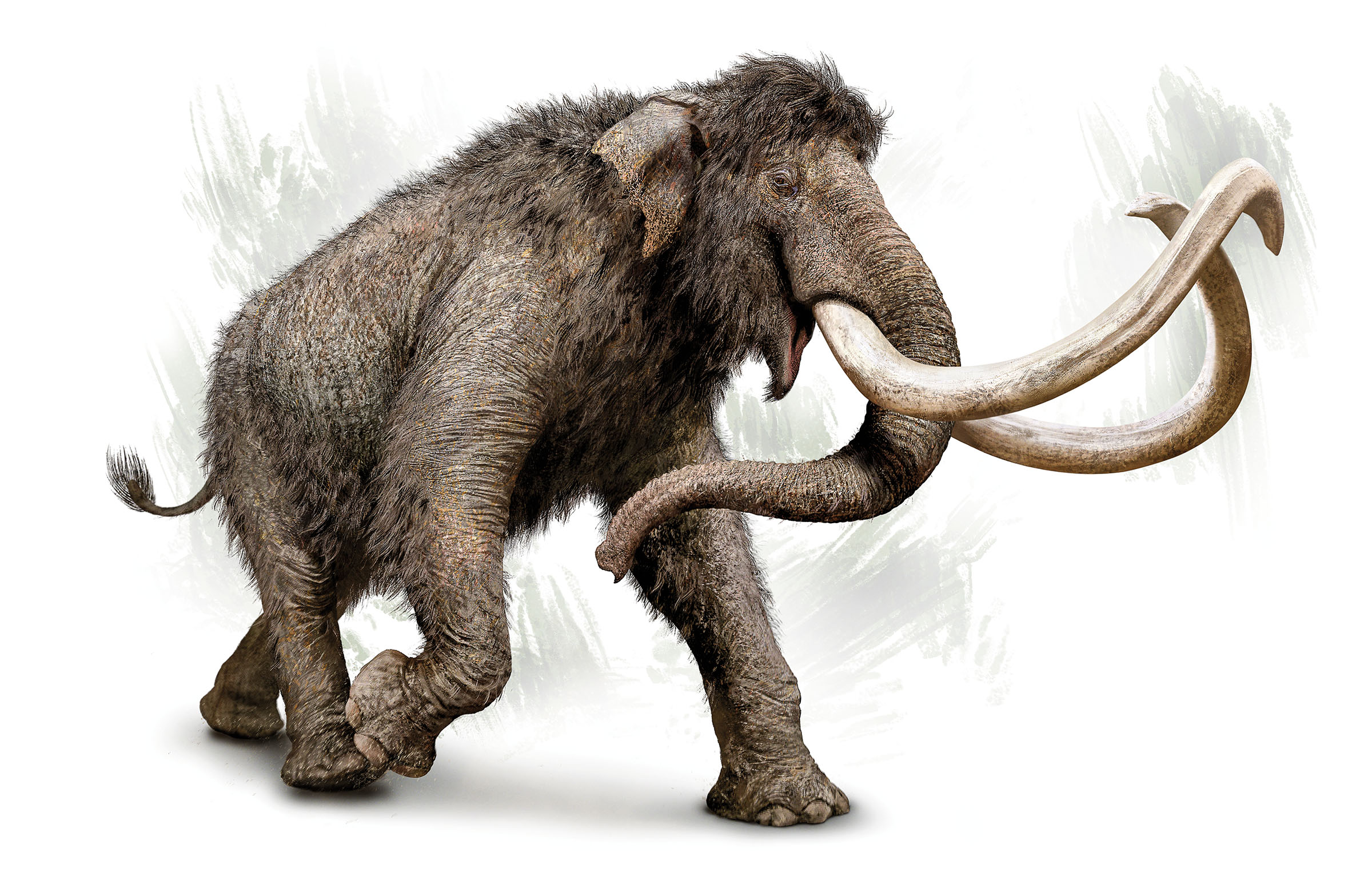
The Waco Mammoth National Monument offers multiple short hiking trails, but the main attraction is the enormous dig shelter, which is climate controlled to protect the fossils and quarry inside. Visitors can enter over an elevated walkway to see multiple mammoth skeletons still lying in the sediment, compare themselves to a life-size painting of an enormous pachyderm, or take in a charming—if out-of-date—mural of a mammoth herd washing away in a flood. The artwork is based on a past hypothesis of what caused the animals’ demise; Yann says the current hypothesis is that it was caused by a massive drought.
The Waco mammoth site is the only national park unit to have all its fossils in the same town as the National Monument, says park paleontologist Lindsey Yann. Many of those remains are held at Baylor, but some are still in the ground inside the climate-controlled dig shelter, where visitors can watch paleontologists from a suspended catwalk.
Yann points out the individual animals amid the remains. One upper terrace of dirt holds the collapsed form of an enormous bull mammoth, with a tangle of baby mammoth bones around its tusks. Even lower, in another layer of sediment, lie the remains of a female mammoth and the disarticulated skeleton of a camel.
Yann hopes that future excavations will soon begin working through the banks of dirt inside the shelter to uncover more clues as to the Waco mammoths’ fate and give us a glimpse into one more of Texas’ many lost worlds.
Waco Mammoth Site National Monument
6220 Steinbeck Bend Drive, Waco.
Open daily 9 a.m.-5 p.m.
254-750-7946; nps.gov/waco
OTHER PLACES TO SEE TEXAS FOSSILS
The fossil displays of the Houston Museum of Natural Science contain a good amount of Permian material from Seymour, as well as reconstructions of dinosaurs found in traces at Glen Rose and Big Bend. So does the Perot Museum of Nature and Science in Dallas, which has a full-size Alamosaurus reconstruction, and the Texas Science & Natural History Museum in Austin, which contains real fossils from the Texas Permian to its Ice Age. In Hillsboro, Texas Through Time likewise contains a remarkable collection.
Want to try your hand at collecting fossils? Most fossil collecting in Texas requires either the permission of private landowners or a scientific permit. But you can visit the Mineral Wells Fossil Park and freely collect the remains of ancient coal age shells, crinoids, and sharks. If you’re near Dallas, drive out to the Ladonia Fossil Park along the North Sulfur River, where the rock of the riverbed contains remnants of Cretaceous seas including ammonites, bits of petrified wood, and the teeth of sea-going lizards called mosasaurs. Make sure to bring a bag, plenty of water, and sun protection.
If you find a fossil while out on state or federal land, leave it alone. Mark the GPS coordinates, take a picture, and report it to park staff.








